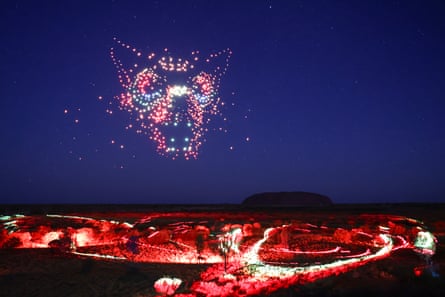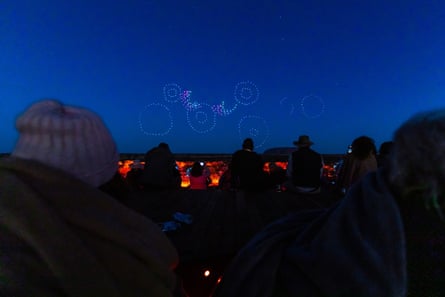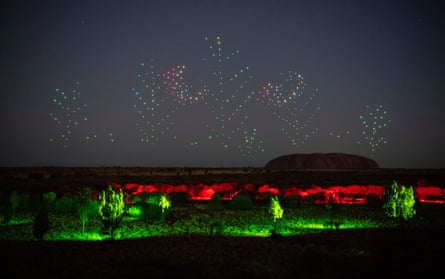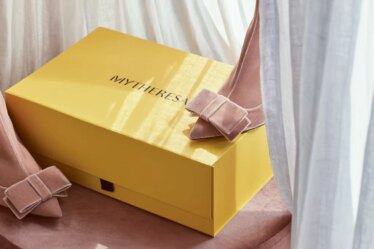
Deep in the central Australian desert, I sit atop a dune, looking up at the sky. A blanket of stars stretch over Uluru. Woven among them, the movement of artificial colours and light telling an ancient story come to life.
Red blurs into blue, which blurs into green until a shape forms: a bird moving slowly through the night. It morphs into a looming dog that is struck by the spear of a kingfisher woman, exploding into hundreds of tiny orbs. They float apart slowly, turning white. I lose them among the stars.
Wintjiri Wiru
In the local Anangu language, Wintjiri Wiru, means “beautiful view over the horizon”.
It is the name of the world’s largest permanent drone show, which had its global launch on Wednesday after five years and a $10m investment.
More than 1,100 RGB-lit drones filled the sky above Uluru with three-dimensional artwork telling the Mala ancestral story – just one chapter of stories sacred to the Anangu.
The visuals are backed by narration in the Pitjantjatjara and Yankunytjatjara languages, with English translation, and a soundtrack of traditional music.
As the story begins, 400 drones launch from a platform hidden behind mulga shrub. They move in programmed synchronicity, depicting an evil spirit disguised as trees, rocks and birds sent to destroy the Mala.
The spirit takes its final form as Kurpany, a devil dog, made of 800 drones looming 200 metres above the audience. The kingfisher woman senses the spirit and warns her people, but they don’t listen.
The Mala men are attacked and flee, but the kingfisher woman destroys the spirit and the women are spared.
The story says the Mala women still live at Uluru today.
Developed by Voyages Indigenous Tourism Australia in partnership with the Anangu community, visitors view the show on a floating platform between Uluru and Kata Tjuta, backlit by the artwork of local Anangu artist Christine Brumby. It will run every night until February.
The premium three-hour sunset dinner, priced at $385 per person, serves canapes, cocktails and hot native-inspired dishes paired with Australian wines.
A shorter one-and-a-half hour after dark show costs $190pp and serves wattleseed caramel popcorn alongside gelatos featuring native ingredients.
‘Carrying their voices with us’
“When we saw the result of all the work we felt quite overcome,” Rene Kulitja, a senior Anangu woman and artist, says on behalf of the Wintjiri Wiru consultation group.
“It was amazing that it came from our tjukurpa, our story, our understanding of the world.”
Generations of Anangu ancestors carry cultural knowledge through tjukurpa, which are lessons that cannot be passed on in writing, Kulitja says.
“They go into your heart and spirit. They connect with understanding, with soul. They are things you have to hold in your being.”

For Denise, another Anangu woman, tjukurpa comes from hearing and seeing.
“When I was young, I would hear stories from my grandmother, every night and early morning,” she says.
“She would draw a picture in the ground, and I could see what she was telling me. While she did that, she would sing a song. Then rug weaving, always with a picture, always singing. Wax oil on a sheet. Wooden carvings with designs. All along, she would sing the same song, and I would listen.
“She passed away and it is my turn to draw the picture, tell the same story, sing the same song.
“When we see the colours, pictures, patterns and hear the voices of our grandparents in the light show, we are carrying their voices with us.”
after newsletter promotion
‘The voice and sound of the desert’
The origin of the show’s sound and light is a mystery to the audience.
“This is the voice and sound of the desert,” Bruce Ramus says. “When you watch the show you feel it. You don’t think about drones or lasers or speakers.”
Ramus is a Canadian light artist who programmed and produced Wintjiri Wiru.

The project, which aims to tread lightly on the land, encountered environmental challenges – from designing drones to resist wind, rain and dust, to building projector and light stations around the flora and fauna of the ground.
But technology was a secondary concern, Ramus says. “First, it was how do we tell this story?”
The process started by disregarding technology.

“We were thinking about the light and scale of this place. It was about listening deeply. To understand this country, its people, you have to listen from your heart.”
It was about developing technology to enable telling of a multi-dimensional story, Ramus says.
“The video projectors, drones, lights, begin on the ground and go all the way up to sky country to do that.”
‘We won’t be the generation who loses the eons of story’
The Voyages CEO, Matt Cameron-Smith, says the process of producing Wintjiri Wiru was led by “walking with community to learn, understand and articulate this story in the right way”.
“The story belongs to the Anangu, so the Anangu should benefit from the story being told.”
Voyages worked with Indigenous copyright lawyers Terri Janke and Company, everybody was paid according to the Arts Law Centre, and all decisions from colour to sound were made with senior Anangu.
“Tourists have been coming for a long time. But it has taken a long time to develop something like this. We want more people to come out and see parts of our country,” Kulitja says. “What we are telling you comes from the depths of our hearts and spirits.”
Rhoda Roberts, a Widjabul woman and acclaimed artistic director, helped navigate the consultation between the Anangu and Voyages Indigenous Tourism Australia.
“I sit here and think of what a historic moment this is – the work conducted by our people, the generosity and knowledge they can give,” Roberts says.
“It fills my heart because we remember the grandparents who fought to ensure we inherited the birthright of caring after the land and sky, who knew stories had to be passed on.
“This assures we won’t be the generation who loses the eons of story.”
-
Rafqa Touma attended Wintjiri Wiru courtesy of Voyages Indigenous Tourism Australia and Tourism NT


